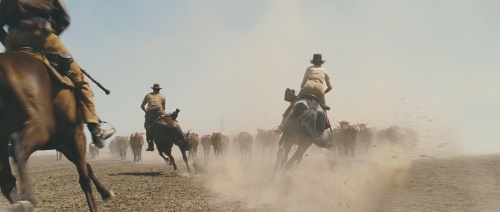Australia (Baz Luhrmann, 2008)
I’m late to the party on Australia, so this is going to be a belated defence of it. While it’s true that it has generally been positively reviewed (at least in its home country), when a film is as hyped as this one is, faint praise damns. Mix in a few very prominent or particularly negative reviews (such as Luke Buckmaster’s over at InFilm Australia, here), the less-than-expected box-office, and the complete dissipation of any Oscar buzz, and I think it’s fair to say that a sense of disappointment has built around Australia. This was part of the reason that I was so late in seeing the film. I had been pumped for it after seeing the trailers, but it had slipped down in my priorities as it became clearer that Luhrmann hadn’t pulled a rabbit out of his hat and produced a masterpiece. When I finally did see it, though, I was pleasantly surprised. Taken on its own terms, Australia is of course no classic, but it is nevertheless highly enjoyable.
What’s fun about it is how ambitious it is: Luhrmann has mixed up elements of the Australian western (The Man From Snow River), effects-laden war film (Pearl Harbour), epic love story / melodrama (Gone With the Wind), leftist social drama (Rabbit Proof Fence), and more old-fashioned attempts to negotiate Australia’s relationship with its indigenous inhabitants (Jedda), and filtered these disparate influences though the heightened style familiar from Luhrmann’s previous work. Try something like that without it being a little bit of a muddle and you’ve made a bona fide classic. As it is, you do feel the gears change, occasionally gratingly, but what’s surprising is how often it does come together. The film is involving, wonderfully shot, and always entertaining.
The difficulty that arises in critiquing such a film is, I think, borne out by the approach of negative reviews such as Luke Buckmaster’s, and the debate played out in the subsequent reader comments to that review and follow-up article (see here and here). A perennial problem with assessing genre films is at work in the debate between the film’s detractors and defenders. Those who dislike the film point to its corniness and its clichés; defenders argue that those clichés are either knowingly employed or simply devices of the genre. (So, for example, it would be silly to deride a western for featuring scenes of a lone figure on horseback riding into a lawless town: that’s a cliché, but it’s also just what happens in a western). The difficulty arises because the latter argument can become a free pass for any kind of cinematic dreck, passing off yesterday’s film as today’s with simply a knowing wink to excuse the derivativeness. I have often struggled with these kind of arguments myself: how do I argue that, say, Star Wars is superior to Independence Day, when at a formal level both are doing much the same job of reviving old narratives and supercharging them with special effects? I don’t pretend to have a neat answer to that question, but the strange alchemy at work in separating the good from bad is one of the things that keeps me interested in writing about genre and blockbuster cinema. Critics sometimes talk derisively about the formulaic nature of such cinema, but this misses the point, which is that you can’t simply mix a film up according to formula and have it work. Similarly, originality is wildly overrated as a criterion for assessment, and in writing about genre films, critics have to be alert to the fact that picking on the derivativeness usually won’t, in itself, tell us anything in a world full of cliché-filled masterpieces like Once Upon a Time in the West. If I am not enjoying a genre film, I will – as Buckmaster clearly did with Australia – find its hackneyed elements grating. But that awareness is much a symptom as a cause; to really be explaining anything about the movie, I think we need to look at why those elements failed to gel, rather than simply pointing them out. Conversely, we can’t give any old genre film a free pass simply because it “doesn’t take itself too seriously” or “is just paying homage.”
As I said, there isn’t an easy answer to how we avoid these difficulties. Part of the answer, though, is to look at technique and execution, and on these counts Australia’s merits are strong. The film is beautiful to look at, with sweeping vistas, gorgeous cinematography, and striking use of the camera. Luhrmann is here still recognisable as the director who made Romeo + Juliet and Moulin Rouge, with a similarly histrionic style still evident, but he has adapted his approach in important ways. In particular, the hyper-kinetic editing which was so striking in Romeo + Juliet and grating in Moulin Rouge has here been tempered a good deal, and there are moments that suggest Luhrmann has belatedly discovered the power of the uninterrupted take. One shot in particular, occurs after a character has drowned in a water tank: the camera rises up from directly above the tank, tilts to show us the entire homestead as characters come running, and finally reveals a police car driving away. It’s a showy shot, but also dramatically effective, as the reveal of the departing vehicle effectively underlines the official indifference to what has just happened. That combination of showmanship with genuine storytelling merit is perfect for the melodramatic nature of the material.

Luhrmann’s stamp is also seen in the approach of his cast, which betrays Luhrmann’s familiar fondness for the highly theatrical and comically grotesque. This means some performances – particularly those providing comic relief – are very broad, but I didn’t find them excessively so in the context of the wider cinematic style Luhrmann uses. Nicole Kidman is fine as the uptight Lady Sarah Ashley: I’m not going to herald it as a great performance (or Kidman as a great actor) but I confess to being a little bewildered at the current vitriol being directed at Kidman over this film and also more widely. (Apparently there is some sort of problem with her forehead that means Kidman must now be mocked and reviled for whatever she does; whatever it is, I didn’t get the memo). Hugh Jackman’s turn as “The Drover” is pure old-fashioned star power, notable not so much for any acting prowess per se as much as his simple macho charisma (it’s almost impossible to imagine the original choice of Russell Crowe making The Drover as appealing). The supporting cast is stacked full of notable Australian actors: if there is a particular sense of patriotism infusing local reviews of Australia, I think it mostly comes from the pleasure of seeing so many of these actors in the one film. Luhrmann has achieved the ultimate Australian cinema casting trifecta by getting Bryan Brown, Jack Thompson and Bill Hunter in the one film (the latter for only one line, but he’s there), and then added Ray Barrett, Max Cullen, David Gulpilil, Ben Mendelsohn, Barry Otto, Bruce Spence and David Wenham for good measure. Wenham, in particular, deserves credit for really entering to the spirit of things, providing a pantomime-style villain who is legitimately threatening and yet knowingly funny. He is a particularly good example of the fine line the film walks between sincere and tongue-in-cheek.
Luhrmann moves the narrative along confidently, even if some elements don’t slot together as well as others: the love story and the stolen generations subplot dovetail neatly, for example, whereas the plot of the Japanese attack on Darwin is less comfortably integrated. Many have highlighted the lumpiness of the narrative, and it’s true that Luhrmann breaks one of the basic rules of film storytelling: never let the audience think the movie has finished when it hasn’t. While I think the film would have benefited greatly from an intermission, I wasn’t too bothered by the shape of the story: narratives that stop and start are a feature of epic movies, inlcuding very good ones such as Gone With the Wind and The Godfather. The film’s most serious flaw is instead actually related to its visual effects. The film builds to a central climax of a cattle stampede by the side of a cliff that needed to be grand and exciting like, say, the buffalo hunt in Dances With Wolves. Unfortunately, however, the scene is unconvincing – to say the least – because too many shots feature ludicrous computer animation rather than real cattle and scenery. (Between this, King Kong, and Indiana Jones and the Kingdom of the Crystal Skull I think it has been definitively established that clifftop action sequences are never a good idea in CGI). There are fake effects elsewhere in the film that do no harm – such as the storybookish shots of Darwin – but here the film needed the real grandeur and adrenaline shot that only comes from mounting a sequence for real.

It might seem counterintuitive to argue that the success of a film like this rests in something as aesthetically disreputable as visual effects, but it is often the case that a good movie becomes great on the strength of one signature sequence. If that sequence had been more effective I think the film would have met with more genuine enthusiasm from both critics and audiences. As it is, however, I think the film will still please audiences who are willing to give themselves over to its considerable pleasures.
